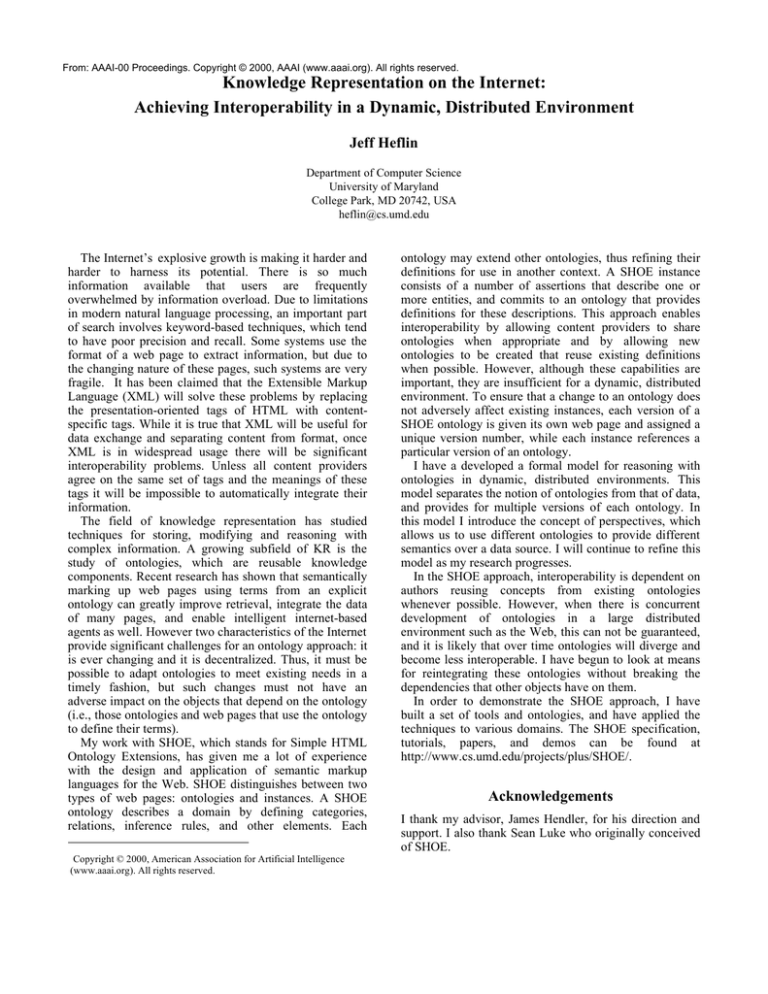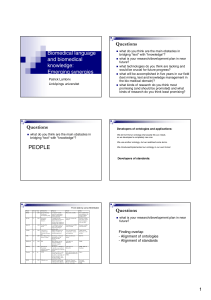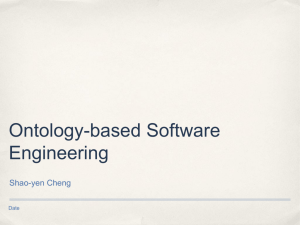
From: AAAI-00 Proceedings. Copyright © 2000, AAAI (www.aaai.org). All rights reserved.
Knowledge Representation on the Internet:
Achieving Interoperability in a Dynamic, Distributed Environment
Jeff Heflin
Department of Computer Science
University of Maryland
College Park, MD 20742, USA
heflin@cs.umd.edu
The Internet’s explosive growth is making it harder and
harder to harness its potential. There is so much
information available that users are frequently
overwhelmed by information overload. Due to limitations
in modern natural language processing, an important part
of search involves keyword-based techniques, which tend
to have poor precision and recall. Some systems use the
format of a web page to extract information, but due to
the changing nature of these pages, such systems are very
fragile. It has been claimed that the Extensible Markup
Language (XML) will solve these problems by replacing
the presentation-oriented tags of HTML with contentspecific tags. While it is true that XML will be useful for
data exchange and separating content from format, once
XML is in widespread usage there will be significant
interoperability problems. Unless all content providers
agree on the same set of tags and the meanings of these
tags it will be impossible to automatically integrate their
information.
The field of knowledge representation has studied
techniques for storing, modifying and reasoning with
complex information. A growing subfield of KR is the
study of ontologies, which are reusable knowledge
components. Recent research has shown that semantically
marking up web pages using terms from an explicit
ontology can greatly improve retrieval, integrate the data
of many pages, and enable intelligent internet-based
agents as well. However two characteristics of the Internet
provide significant challenges for an ontology approach: it
is ever changing and it is decentralized. Thus, it must be
possible to adapt ontologies to meet existing needs in a
timely fashion, but such changes must not have an
adverse impact on the objects that depend on the ontology
(i.e., those ontologies and web pages that use the ontology
to define their terms).
My work with SHOE, which stands for Simple HTML
Ontology Extensions, has given me a lot of experience
with the design and application of semantic markup
languages for the Web. SHOE distinguishes between two
types of web pages: ontologies and instances. A SHOE
ontology describes a domain by defining categories,
relations, inference rules, and other elements. Each
Copyright © 2000, American Association for Artificial Intelligence
(www.aaai.org). All rights reserved.
ontology may extend other ontologies, thus refining their
definitions for use in another context. A SHOE instance
consists of a number of assertions that describe one or
more entities, and commits to an ontology that provides
definitions for these descriptions. This approach enables
interoperability by allowing content providers to share
ontologies when appropriate and by allowing new
ontologies to be created that reuse existing definitions
when possible. However, although these capabilities are
important, they are insufficient for a dynamic, distributed
environment. To ensure that a change to an ontology does
not adversely affect existing instances, each version of a
SHOE ontology is given its own web page and assigned a
unique version number, while each instance references a
particular version of an ontology.
I have a developed a formal model for reasoning with
ontologies in dynamic, distributed environments. This
model separates the notion of ontologies from that of data,
and provides for multiple versions of each ontology. In
this model I introduce the concept of perspectives, which
allows us to use different ontologies to provide different
semantics over a data source. I will continue to refine this
model as my research progresses.
In the SHOE approach, interoperability is dependent on
authors reusing concepts from existing ontologies
whenever possible. However, when there is concurrent
development of ontologies in a large distributed
environment such as the Web, this can not be guaranteed,
and it is likely that over time ontologies will diverge and
become less interoperable. I have begun to look at means
for reintegrating these ontologies without breaking the
dependencies that other objects have on them.
In order to demonstrate the SHOE approach, I have
built a set of tools and ontologies, and have applied the
techniques to various domains. The SHOE specification,
tutorials, papers, and demos can be found at
http://www.cs.umd.edu/projects/plus/SHOE/.
Acknowledgements
I thank my advisor, James Hendler, for his direction and
support. I also thank Sean Luke who originally conceived
of SHOE.







